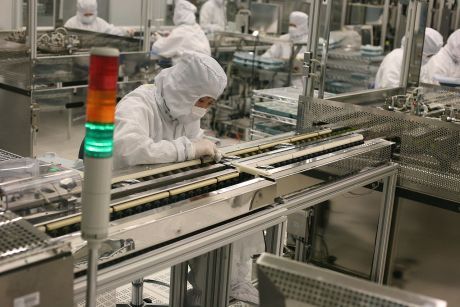Features
You are here
Contradictions and capitalist crisis in the Chinese economy

January 17, 2013
The Shanghai Composite Index rallied in early December when the new leadership of the Chinese Communist Party under the leadership of Xi Jinping announced its commitment to increasing investment in urban development and deepening economic reforms.
Business news commentators welcomed the news of rallying markets and an uptick in the Chinese economy to 8.6-per cent growth in the fourth quarter of 2012 (after falling to a low of 7.4 per cent in the third quarter). Indeed, with a modest recovery in the US housing market, some are suggesting that China and the US will kick-start the global economy.
Yet all the contradictions in the Chinese economy revealed in the immediate wake of the global financial crisis remain, and more sober economists are not as optimistic as the headlines suggest.
China remains dependent on low-cost exports made possible through the combination of Foreign Direct Investment and cheap labour. When demand for exports slumped, first in the US and then in Europe, China weathered the global crisis primarily with mass infusions of cash and credit to fund continued investment in plant and greater investment in infrastructure (including railway tracks to nowhere and vacant cities replete with empty office and apartment towers). But as the Economist notes: “[China’s] momentum is sustained by nothing but an outpouring of investment in plant, infrastructure and property. This appears profitable only because each round of investment creates demand for the products of the previous round. If this investment stopped flowing, China’s economy would fall to earth.”
Capacity
Excess capacity is both a cause and effect of the global economic crisis and persists on a world scale. This explains why capitalists the world-over have largely failed to reinvest in plant and equipment, despite some restoration of profit. Excess capacity needs to be absorbed before capitalists feel confident to reinvest in plant and equipment profitably. It is a dynamic that contributes to continued stock and commodity markets where profits can still be made quickly via speculation. In China, state-driven investment in plant and equipment (as opposed to social spending, for instance) can only exacerbate this contradiction within the global economy, and in China.
For example, in August 2012, the New York Times reported that China has unprecedented levels of unsold goods, with stockpiles of everything from steel to cars. An investment management firm notes: “One challenge is the amount of capacity that is still being added to the country’s manufacturing base. Chinese auto production is expected to grow in the next two years by an amount nearly equal to all of the auto factories in the US.” This excess capacity will put downward pressure on auto prices as firms compete with China to unload their vehicles. As the management firm puts it: “We expect this excess capacity will keep import price inflation subdued here in the US for quite some time.” Indeed, it will also ensure continued attacks on workers’ wages as firms compete for market share and sustain profit margins.
Speculation
In addition to adding to the crisis of over-production, the Chinese stimulus program fuelled stock and real estate speculation. Cheap credit and low interest rates resulted in speculation frenzy. Stock markets climbed, real estate prices rose and inflation soared. In 2011, food prices skyrocketed by a whopping 15 per cent. Food price inflation hurts workers whose wages do not keep up and further depress domestic demand as greater portions of workers’ wages go toward food. It also contributes to workers’ resistance and social instability—a serious concern for the autocratic Communist Party. To control inflation and speculation, the Chinese government increased interest rates, tightened the money supply (tempering infrastructure spending) and tightened banking regulations to mitigate the issuance of risky loans. But just as these problems are mitigated, so arises the problem of slowing GDP growth. The 7.4-per cent growth rate in Q3 of 2012 was an historic low for an economy that has averaged 10 per cent or more for the past three decades.
Unsurprisingly, the Chinese government is once again reducing interest rates to ease credit, expand the money supply, and increase public spending on infrastructure.
But scope for this course of action is certainly smaller for the incoming Communist Party leadership. First, most economists are suggesting that the days of Chinese growth rates of 10 per cent are long gone. (Some economists are predicting growth of less than 5 per cent as early as 2014, which most agree is not fast enough to absorb even modest population growth).
Debt
China’s ability to spend its way out of the crisis is much narrower than it was even 10 years ago. China’s public debt as a percentage of GDP nearly doubled to 34 per cent of GDP between 2009 and 2010. By 2012, China’s public debt was estimated at 43.5 per cent. Perhaps more worrisome is that corporate debt in China has increased from 108 per cent of the entire Chinese economy in 2011 to 122 percent in 2012. As a Bloomberg news report puts it: “Key industries such as steel, construction machinery, aluminum, and coal are facing overcapacity, squeezed margins, and most alarmingly, debt.” Many of these corporations are technically state-owned, which means that the Chinese people will be expected to bailout these over-leveraged enterprises should they fail. The extent of China’s debt obligation, then, becomes significantly higher: “Lump together corporate, public, and household debt,” reports Bloomberg, “and you get a figure close to 206 per cent of GDP.” For an economy estimated to be worth $4.7 trillion US dollars in 2010, a debt obligation worth nearly $9 trillion is a tremendous risk, economically and politically. Bloomberg reports that a bad-loan ratio of only 12 per cent would “erase the banking industry’s [$1.2 trillion US] in capital.”
At the same time, there has been a surge in the “shadow banking” system, where, according to the IMF, “lending is to higher-risk entities including local government investment vehicles and property developers that don’t have access to bank loans.” Adam Wolfe, an economist with Roubini Global Economics, suggests these bad debts will impair the banks’ ability to lend and will choke off investment in the year ahead, increasing concerns about a “hard landing” in China. According to Wolfe: “Faster growth now only pushes China closer to the inevitable sharp slowdown that will come when its debt-fueled, investment-led growth model collapses.” (Such a scenario will have grave implications for commodity prices and economies—like Canada—that have prioritized commodity exports assuming sustained rapid growth in China).
Currency
Part of China’s growth model has been its currency advantage relative to the US economy. Low value currencies make exports cheaper and helps sustain demand for them. But the global slump in demand over the past four years has hurt China’s exports, since Europe and the US could not absorb as many Chinese goods. Although China has typically intervened to prevent the Chinese currency—the Renminbi (Yuan)—from increasing in value relative to the US dollar as a means of keeping its exports competitive (the Renminbi was officially pegged to the US dollar until 2005), China has been diversifying its reserve holdings away from US dollars, buying instead, the debt of its other important trading partners. As a result, countries like Japan and South Korea are now purchasing more US treasury bills to prevent their own currency from rising against the dollar. This is partly because US monetary policies in the aftermath of the global crisis put downward pressure on the US dollar, making it more risky for China to purchase US currency to retain its value against the Renminbi (and simultaneously de-valuing the US dollar assets already held by China). This dynamic has narrowed the value gap from about 30 per cent to 8 per cent between the Renminbi and the dollar, and eroded China’s currency advantage.
According to the Bank for International Settlements, the global currency market has more than doubled since 2004 as currency speculation has grown alongside stock market speculation. This is another wrinkle in the economic terrain; the increasing size of this market dilutes the relative impact of any nation state’s ability to intervene to keep the value of its own currency in check.
Demand
Still, there remains the question of domestic demand, long considered the holy grail of the Chinese economy. At present, domestic consumption accounts for only about 35 per cent of the Chinese economy and increasing this proportion appears to offer the potential for a resurgence of domestic demand-driven growth and the new Communist Party leadership has promised to take measures to stimulate it. However, a meaningful expansion of domestic demand would require unprecedented wealth redistribution, especially in the form of rising wages and increased state spending on social programs. But in a global capitalist market, China’s abundant supply of cheap labour has been a competitive advantage, and one upon which China still depends. Although nominal wages have increased somewhat in China, they have not done so dramatically. Nevertheless, even modest wage growth has helped re-direct FDI toward even lower-wage economies like Bangladesh, Cambodia, Indonesia and Vietnam, and FDI fell significantly throughout 2012. Thus, despite slumping exports and a diminishing trade surplus, China is counting on re-vitalizing itself as an FDI destination; despite double-digit wage improvements in the first half of 2012, by year’s end, wage growth had declined by six percent. In this context, the Chinese government will be loathe to make meaningful improvements in wages and—by extension—domestic demand.
Liberalization
The Communist Party has raised expectations for “liberalization.” Economic growth in a world market does require some “opening up” of the Chinese economy and, as it progresses, it simultaneously raises expectations among the Chinese population that liberalization will entail both economic and political reforms. These expectations can spill over into domestic protest alongside struggles for improvements in wages and working conditions.
For example, on New Year’s Day, workers at Southern Weekly—a newspaper in the city of Guangzhou—took strike action to protest Chinese state censorship of an editorial that had called for constitutional change. When newspaper staff went on strike, hundreds joined them in solidarity demonstrations demanding the resignation of Tuo Zhen, the provincial propaganda tsar of the Chinese Communist Party. Hundreds of other workers and intellectuals have condemned the censorship and signed an open letter also demanding Tuo’s resignation: “In recent days, the general attitude at home and overseas following the 18th National Congress has been one of optimism over China’s prospects. The actions of Minister Tuo Zhen, in Guangzhou and on the very front lines of reform and opening, are entirely contrary to the [new] policy orientation.”
In relatively bold moves, some newspapers refused to run a subsequent state-sanctioned editorial that criticized the actions of the journalists at Southern Weekly, while other newspaper outlets only printed it alongside a disclaimer that translated as “posting this piece does not mean sharing the views expressed.” Some observers believe this is China’s first direct confrontation between newspaper workers and state officials. Since Communist Party propaganda departments supervise the Chinese media and penalties for political dissidence are high, there has until now been little room for resistance. The dissent—and strike—of Southern Weekly workers underlines the contradictions the Communist Party unleashes when it promises liberalization on the one hand, but expects business as usual on the other. As a different state-run newspaper editorial stated: “The reality is that old media regulatory policies cannot go on as they are now. The society is progressing, and the management should evolve.”
It is unlikely that the Chinese and US economies will be ‘kick-starting’ the global economy in 2013. A more likely scenario is one in which Chinese workers find increasing cause to resist both economically and politically in mutually reinforcing struggles. When they do, international solidarity—especially from Western workers—will be critical.
Section:
Topics:
- Log in to post comments










